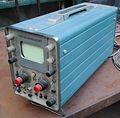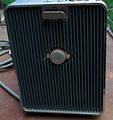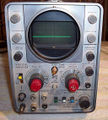321: Difference between revisions
Nixiebunny (talk | contribs) |
No edit summary |
||
| (32 intermediate revisions by 5 users not shown) | |||
| Line 1: | Line 1: | ||
{{Oscilloscope Sidebar | | {{Oscilloscope Sidebar | ||
|manufacturer=Tektronix | |||
summary=Portable single channel scope | | |series=300-series scopes | ||
image=Tek 321 trace.jpg|321 front view | | |model=321 | ||
caption=Tek 321 front | | |summary=Portable single channel scope | ||
introduced=1960 | | |image=Tek 321 trace.jpg|321 front view | ||
discontinued=1972 | | |caption=Tek 321 front | ||
manuals= | |introduced=1960 | ||
*[ | |discontinued=1972 | ||
*[ | |designers=Oz Svehaug;Oliver Dalton;Hiro Moriyasu | ||
*[ | |manuals= | ||
*[ | * [[Media:070-196.pdf|Tektronix 321 Manual 070-196]] | ||
* | * [[Media:070-0425-01.pdf|Tektronix 321A Manual 070-0425-01]] S/N 100-5999 (OCR) | ||
* [[Media:Tek 321 irb.pdf|Tektronix 321 Instrument Reference Book]] (OCR) | |||
* [[Media:Tek 321a mod 128A.pdf|Tektronix 321A Mod 128A]] | |||
* [[Media:070-0891-00.pdf|Tektronix 321A SN 6000 up]] (OCR) | |||
* [[Media:321 announce.pdf|Tektronix 321 Announcement]] | |||
* [[Media:070-425.pdf|Tektronix 321A Manual]] (OCR) | |||
* [[Media:tek_321_fcp.pdf|Tektronix 321 factory calibration procedure]] (bad-OCR) | |||
* [[Media:Tek 321a fcp june 1968.pdf]] | |||
* [[Media:Tek 321 mod 797A.pdf]] | |||
* [[Media:Tek 321 mod 799F.pdf]] | |||
* [[Media:Tek 321 single sweep lockout early schematics.pdf]] | |||
* [[Media:Early tek 321 schematics.pdf]] | |||
}} | }} | ||
The '''Tektronix 321''' is a very compact single-trace, single-timebase portable oscilloscope that is almost completely solid state. | The '''Tektronix 321''' is a very compact single-trace, single-timebase portable oscilloscope that is almost completely solid state. | ||
Design work took place in 1959 and it was [[introduced in 1960|introduced on April 8th, 1960]]. | |||
It was designed by [[Oz Svehaug]], [[Oliver Dalton]], and [[Hiro Moriyasu]]. | |||
The 321 includes several germanium bipolar transistors, which are a known reliability problem. | The 321 includes several germanium bipolar transistors, which are a known reliability problem. | ||
The 321A was [[introduced in 1964]]. The 321 and 321A have slightly different circuits. | The '''321A''' was [[introduced in 1964]]. The 321 and 321A have slightly different circuits. | ||
Early instances of the 321 (sn pre-720) use a [[5718]] peanut tube as the front-end cathode follower. | Early instances of the 321 (sn pre-720) use a [[5718]] peanut tube as the front-end cathode follower. | ||
Later 321 and 321A use a [[7586]] Nuvistor for that role. Latest 321A (SN6000 up) use a FET [[151-1011-01]]. | Later 321 and 321A use a [[7586]] Nuvistor for that role. Latest 321A (SN6000 up) use a FET [[151-1011-01]]. | ||
In several circuits, the 321 uses [[OC170]] transistors where the 321A uses [[2N2207]] transistors. | In several circuits, the 321 uses [[OC170]] transistors where the 321A uses [[2N2207]] transistors. | ||
==Power Supply== | |||
The 321 uses a DC-DC converter to generate the DC voltages needed for the scope. | |||
Prior to serial number 720, 321s used the [[120-153]] transformer along with a separate high voltage power supply with its own transformer | |||
the +3350 V CRT anode voltage. | |||
Starting at serial number 720, all DC voltages (including the CRT anode voltage, via a voltage multiplier) are generated by a single power supply | |||
based on the [[120-210]] transformer. | |||
{{BeginSpecs}} | {{BeginSpecs}} | ||
{{Spec | Bandwidth | 5 MHz (321) / 6 MHz (321A) }} | {{Spec | Bandwidth | 5 MHz (321) / 6 MHz (321A) }} | ||
{{Spec | Rise time | 70 ns (321) / 64 ns (321A) }} | {{Spec | Rise time | 70 ns (321) / 64 ns (321A) }} | ||
{{Spec | Sweep | 0.5 μs/Div to 0.5 s/Div, | {{Spec | Sweep | 0.5 μs/Div to 0.5 s/Div, 1–2–5, ×5 magnifier (i.e. to 50 ns/Div) }} | ||
{{Spec | Deflection | 10 mV/Div to 20 V/Div }} | {{Spec | Deflection | 10 mV/Div to 20 V/Div }} | ||
{{Spec | Input impedance | 1 MΩ // 35 pF }} | {{Spec | Input impedance | 1 MΩ // 35 pF }} | ||
{{Spec | Calibrator | 0.5 V<sub>p-p</sub>, about 2 kHz }} | {{Spec | Calibrator | 0.5 V<sub>p-p</sub>, about 2 kHz }} | ||
{{Spec | CRT | [[154-433|T3211-31]] or [[154-433]], P31 phosphor, 10 × 6 Div. @ 6.25 mm (0.25"), 4 kV acceleration }} | {{Spec | CRT | [[T3210]] or [[154-433|T3211-31]] or [[154-433]], P31 phosphor, 10 × 6 Div. @ 6.25 mm (0.25"), 4 kV acceleration }} | ||
{{Spec | AC Power | | {{Spec | AC Power | 90–136 V or 180–272 V, 20 W }} | ||
{{Spec | DC Power | 11. | {{Spec | DC Power | 11.5–35 V, 8.5 W min., 24.5 W max., 700 mA current typ. }} | ||
{{Spec | Battery | Ten size "D" NiCd cells, runtime 5 h (4 Ah cells), 3 h (2.5 Ah cells), charge time 16 h }} | {{Spec | Battery | Ten size "D" NiCd cells, runtime 5 h (4 Ah cells), 3 h (2.5 Ah cells), charge time 16 h }} | ||
{{Spec | Dimensions | 21.67 cm × 14.6 cm × 40 cm (8.5" × 5.75" × 16") }} | {{Spec | Dimensions | 21.67 cm × 14.6 cm × 40 cm (8.5" × 5.75" × 16") }} | ||
| Line 88: | Line 107: | ||
tek-321-round-front.jpg | 321 round front | tek-321-round-front.jpg | 321 round front | ||
tek-321-round-vs-rect.jpg | 321 round vs. rectangular models | tek-321-round-vs-rect.jpg | 321 round vs. rectangular models | ||
321_pair.JPG | 321 and 321A | |||
321_front.jpg|321 front view | 321_front.jpg|321 front view | ||
321_right_case.jpg|321 right case | 321_right_case.jpg|321 right case | ||
| Line 96: | Line 116: | ||
321A_FET.JPG|Latest 321A's frontend | 321A_FET.JPG|Latest 321A's frontend | ||
Tek 321a trace.jpg|321A trace | Tek 321a trace.jpg|321A trace | ||
Tek 321a trace2.jpg|321A trace | |||
321SN1557.jpg|321 with no model number on panel | 321SN1557.jpg|321 with no model number on panel | ||
Tek 321a bottom.jpg|321A bottom view | |||
</gallery> | </gallery> | ||
{{Parts|321}} | |||
{{Parts|321A}} | |||
[[Category:Portable scopes]] | [[Category:Portable scopes]] | ||
[[Category:300 series scopes]] | [[Category:300 series scopes]] | ||
Latest revision as of 17:34, 27 November 2023
The Tektronix 321 is a very compact single-trace, single-timebase portable oscilloscope that is almost completely solid state. Design work took place in 1959 and it was introduced on April 8th, 1960. It was designed by Oz Svehaug, Oliver Dalton, and Hiro Moriyasu.
The 321 includes several germanium bipolar transistors, which are a known reliability problem.
The 321A was introduced in 1964. The 321 and 321A have slightly different circuits. Early instances of the 321 (sn pre-720) use a 5718 peanut tube as the front-end cathode follower.
Later 321 and 321A use a 7586 Nuvistor for that role. Latest 321A (SN6000 up) use a FET 151-1011-01. In several circuits, the 321 uses OC170 transistors where the 321A uses 2N2207 transistors.
Power Supply
The 321 uses a DC-DC converter to generate the DC voltages needed for the scope. Prior to serial number 720, 321s used the 120-153 transformer along with a separate high voltage power supply with its own transformer the +3350 V CRT anode voltage. Starting at serial number 720, all DC voltages (including the CRT anode voltage, via a voltage multiplier) are generated by a single power supply based on the 120-210 transformer.
Key Specifications
| Bandwidth | 5 MHz (321) / 6 MHz (321A) |
|---|---|
| Rise time | 70 ns (321) / 64 ns (321A) |
| Sweep | 0.5 μs/Div to 0.5 s/Div, 1–2–5, ×5 magnifier (i.e. to 50 ns/Div) |
| Deflection | 10 mV/Div to 20 V/Div |
| Input impedance | 1 MΩ // 35 pF |
| Calibrator | 0.5 Vp-p, about 2 kHz |
| CRT | T3210 or T3211-31 or 154-433, P31 phosphor, 10 × 6 Div. @ 6.25 mm (0.25"), 4 kV acceleration |
| AC Power | 90–136 V or 180–272 V, 20 W |
| DC Power | 11.5–35 V, 8.5 W min., 24.5 W max., 700 mA current typ. |
| Battery | Ten size "D" NiCd cells, runtime 5 h (4 Ah cells), 3 h (2.5 Ah cells), charge time 16 h |
| Dimensions | 21.67 cm × 14.6 cm × 40 cm (8.5" × 5.75" × 16") |
| Weight | unknown, about 5 kg |
| Features |
|
External Power Connector
Douglas W Jones wrote:
I've got a Tektronix 321 scope (serial number 001917) that I need to run from an external DC supply. The problem is, I have only the line cord, and not the DC cord. The power input plugs on the scope are obviously custom, long predating the standard IEC plug everyone uses today.
So I improvised. The pin spacing for the 3-pin DC input plug is very close to the spacing of Molex 6, 9 and 12-pin plugs, and the pin diameter is not too much larger than Molex uses. So, I picked up a 6-pin Molex housing and 3 female molex pins, and then cut the housing down to 4 pins (using my pocket knife).
I used an old IEC cord for the DC input wires, with the plugs cut off both ends. I attached the wires on one end to the molex pins and pushed them into the housing, then jammed to housing down onto the Tektronix connector (this flared the female Molex pins to fit the Tektronix pins. The other end of the DC power cord got banana plugs to fit the output posts of my DC power supply.
The net result works fine, plugs and unplugs nicely, and unlike other power supply solutions I've seen, involves no changes to the scope.
Added note: My bench supply has an analog Ammeter on it. The starting surge of the 321 is about 1.5 amps, perhaps 2, tapering down to 0.7 amps in under a second. It seems to draw a steady 0.7A regardless of what you're doing with it. The current drain doesn't change when you vary the supply from 12 to 18V — this is because the 321 uses a linear regulator.
Links
Pictures
-
321 rectangular front
-
321 round front
-
321 round vs. rectangular models
-
321 and 321A
-
321 front view
-
321 right case
-
321 left internal
-
321 right internal
-
321 rear view
-
321 with round bezel
-
Latest 321A's frontend
-
321A trace
-
321A trace
-
321 with no model number on panel
-
321A bottom view
Some Parts Used in the 321
| Part | Part Number(s) | Class | Description | Used in |
|---|---|---|---|---|
| 120-153 | 120-153 | Discrete component | power transformer | 321 |
| 120-210 | 120-210 | Discrete component | power transformer | 321 • 321A |
| 5718 | 154-0053-00 | Vacuum Tube (Triode) | subminiature high-frequency triode | 321 • P500CF • P170CF |
| 7586 | 154-0306-00 | Vacuum Tube (Triode) | Nuvistor triode | M • 1A1 • 1A2 • 1A5 • 10A2 • 10A2A • 11B1 • 11B2A • 321 • 321A • 3A1 • 3A1S • 3A3 • 3A5 • 3A6 • 3A7 • 3A8 • 3A74 • 3S76 • 3T77 • 3T77A • 3B5 • 4S1 • 4S2 • 6R1 • 6R1A • 9A1 • 9A2 • 82 • 86 • S-311 |
| OC170 | Discrete component | alloy-diffused Germanium PNP transistor | 321 • 661 | |
| T3210 | 154-0226-00 • 154-0293-00 • 154-0294-00 • 154-0295-00 • 154-0347-00 • 154-0385-00 | CRT | 3" CRT | 321 |
| T3211 | 154-0442-00 • 154-0443-00 • 154-0444-00 • 154-0433-00 | CRT | 3" CRT | 321 |
Some Parts Used in the 321A
| Part | Part Number(s) | Class | Description | Used in |
|---|---|---|---|---|
| 120-210 | 120-210 | Discrete component | power transformer | 321 • 321A |
| 2N2207 | 151-063 • 151-0063-00 | Discrete component | germanium PNP transistor | 3B1 • 3B3 • 3S76 • 321A • 547 |
| 7586 | 154-0306-00 | Vacuum Tube (Triode) | Nuvistor triode | M • 1A1 • 1A2 • 1A5 • 10A2 • 10A2A • 11B1 • 11B2A • 321 • 321A • 3A1 • 3A1S • 3A3 • 3A5 • 3A6 • 3A7 • 3A8 • 3A74 • 3S76 • 3T77 • 3T77A • 3B5 • 4S1 • 4S2 • 6R1 • 6R1A • 9A1 • 9A2 • 82 • 86 • S-311 |

















